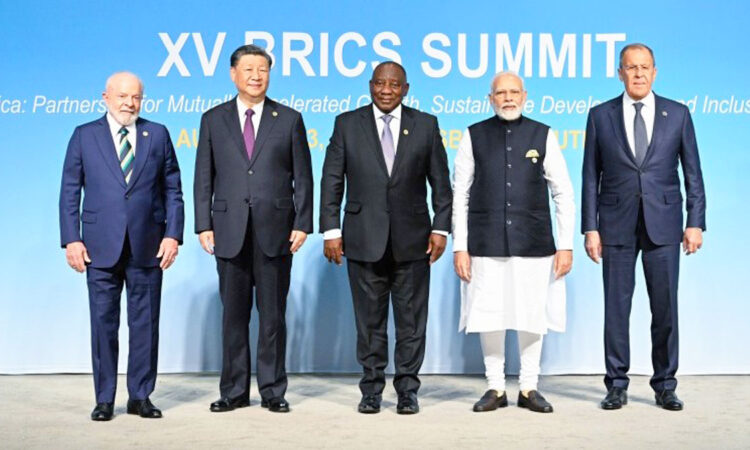
This article is a copy of the original article on Think.ing.com
The big surprise from the BRICS summit in South Africa is that Saudi Arabia has been invited to join the group of major emerging countries. And that’s adding fresh impetus to the de-dollarisation debate, which is a potential challenge to the dominance of the US dollar in global trade
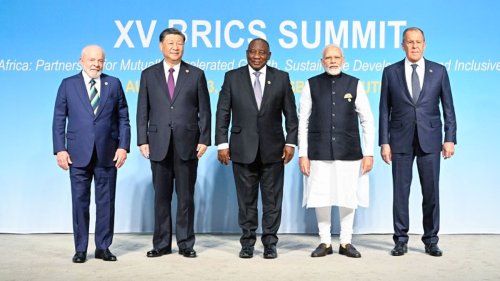
Chinese President Xi Jinping, South African President Cyril Ramaphosa, Brazilian President Luiz Inacio Lula da Silva, Indian Prime Minister Narendra Modi and Russian Foreign Minister Sergei Lavrov at the 15th BRICS Summit in South Africa
Accelerated expansion
We knew that the expansion of the BRICS grouping was top of the agenda at this 15th BRICS summit in South Africa. We had thought that the United Arab Emirates (UAE), Egypt and Bangladesh would be invited to join given they were already part of the BRICS’s New Development Bank. In the end, it was not only the UAE and Egypt invited to join, but also Saudi Arabia, Iran, Argentina and Ethiopia.
The biggest surprise is Saudi Arabia. It had been rumoured that the country wanted to enter the group, but the geo-political situation – given tense relations with the West – raised doubts about whether Saudi Arabia would formalise political and economic ties with the BRICS.
Together with fellow oil and gas exporters Iran and the UAE, the admission of Saudi Arabia to the BRICS grouping will inevitably focus debate on the use of non-dollar currencies in trade. As an aside, at this conference, Brazil proposed to Argentina that Brazil would guarantee Argentine payments for Brazilian exports in renminbi. This is perhaps a reflection of Argentina’s ability to tap renminbi swap lines and expose the scarcity of dollars. Additionally, Argentina remains in dire financial straits as it struggles to source hard currency to service largely dollar-denominated debt.
Oil production split – BRICS vs Rest of World, and Saudi crude exports by destination (%, 2022)

Energy Institute, ING Research
Saudi switch to non-dollar invoicing?
The recently-announced news that a handful of countries, including Saudi Arabia, the UAE and Iran have been invited to join BRICS increases the energy dominance of the group, specifically when it comes to crude oil. As it stands, BRICS members make up around 20% of global oil output. The addition of Saudi, the UAE and Iran would see the BRICS group make up almost 42% of global crude oil output.
As for Saudi Arabia, it is the largest crude oil exporter. In 2022, the Kingdom exported around 7.3m b/d of crude oil, which makes up a little more than 17% of global crude oil exports. The bulk of these exports (76%) go to Asia, of which 35% go to BRICS members China and India.
Therefore, given the ambitions of the BRICS to de-dollarise, there certainly will be increased speculation that this latest move could see Saudi Arabia increasingly switching to non-dollar-denominated currencies for oil trade. To some, it might make sense that Saudi Arabia starts accepting the Chinese yuan and Indian rupee from China and India for its crude oil. And there has been plenty of noise and reportedly discussions between Saudi Arabia and China on the matter. However, up until now, it does not appear as though the Saudis have been willing. The fact that the Saudi riyal is pegged to the US dollar might mean that the Saudis are reluctant to start making the shift.
However, where we have seen a shift is obviously in relation to Iran. Given sanctions, any buyers of its crude will be paying in non-dollar currencies. China is the largest buyer of Iranian oil at the moment and is reportedly paying in yuan.
Will BRICS expansion accelerate de-dollarisation?
In our recently published report, we speculated on which countries could join BRICS and also examined all the evidence of de-dollarisation to date. We concluded that de-dollarisation had been very slow and that where market share had been lost by the dollar, it had largely been taken by the Chinese renminbi in the Asia space.
News of this faster expansion – especially among the oil exporters – clearly adds some momentum to the de-dollarisation debate. We would reiterate, however, that energy only comprises 15% of global trade and that Saudi pricing oil exports to China and India in non-dollar currencies does not spell the end of the dollar as the international currency of choice.
As we argued, the liability role of an international currency is crucially important. Until international issuers and investors are happy to issue and hold international debt in non-dollar currencies – and the take-up of CNY Panda bonds has been very slow indeed – we suspect this will be a decade-long progression to a multi-polar world, a world in which perhaps the dollar, the euro and the renminbi become the dominant currencies in the Americas, Europe and Asia respectively.
The Saudi peg question
Away from the implications of how quickly the dollar’s role as the only international currency is challenged, we are also interested in what this all means for the Saudi riyal, which has been pegged to the dollar at SAR3.75/USD since the 1980s.
Any occasional bouts of speculation against the riyal – largely through the FX forwards market – have been quickly fought off by Saudi authorities. Should the Saudis start to de-dollarise their economy through increasing receipts on non-dollar currencies, investors may start to question whether changes will be coming to the peg – e.g. should the riyal be managed against a basket of currencies rather than against the dollar alone?
Presumably, Saudi authorities will not welcome this speculation, but expect investors to now keep a close eye on the 12-month USD/SAR forward, currently trading at 3.7570 and very close to the peg. This 12m forward can trade over 3.85 at times of speculation over a weaker riyal.
BRICS expansion in the context of global trade
Putting the proposed expansion of BRICS into the global context, it appears that the new invitees can have a moderate impact on the structure of global trade. Currently, the core BRICS countries control around 23% of global exports and 19% of global imports, and the new members would add 3.7% and 3.0% to that, respectively, with Saudi Arabia being the biggest individual new member in terms of exports and the UAE the biggest new importer. Overall, the new additions would expand the weight of BRICS in global trade by around 16%.
New BRICS invitees account for 3.7% of global exports…
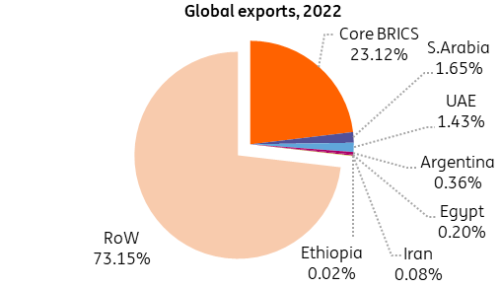
IMF, ING
…and 3.0% of global imports
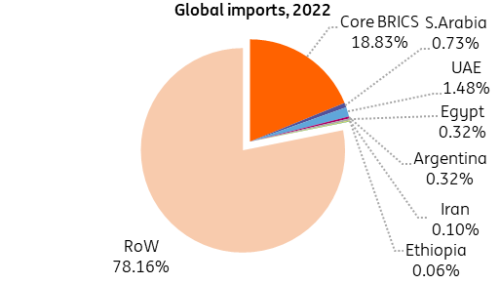
IMF, ING
New members have been increasingly focused on trade with BRICS lately
Looking at the structure of international trade by the new members, their inclusion seems to reflect the growing trade ties with the original BRICS countries. Over the last few years, the share of core BRICS in the new invitees’ imports increased from 23% to 30%, replacing the euro area, USA, and other developed economies. The share of core BRICS in the new additions’ exports also increased but more modestly, from 25% to 28%. The growing trade interconnectedness seems to be providing some fundamental ground for political announcements.
Core BRICS countries have been gaining a role in the new member’s imports…
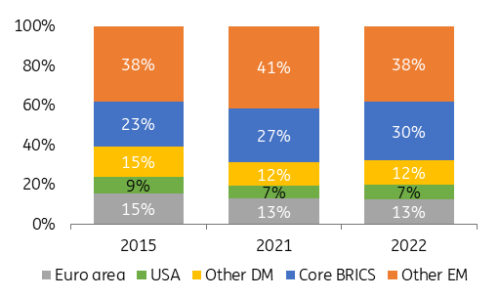
IMF, ING
…and exports
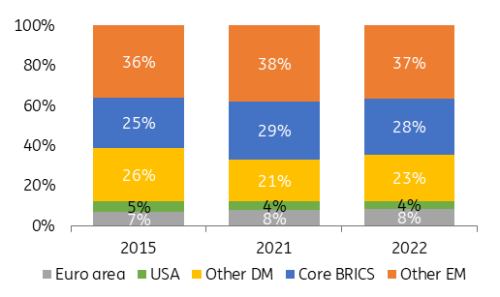
IMF, ING




